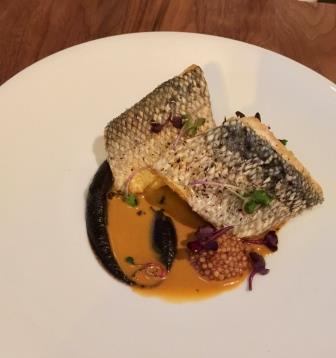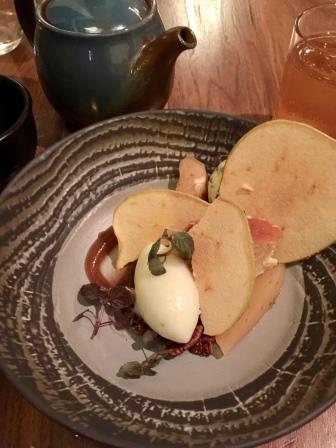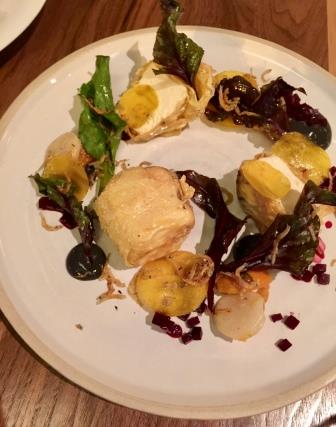New challenge of Long-lasting restaurant, "Sushi Ran", borderless cuisine between Californian and Japanese makes a debut in SF!
By Eri Shimizu / Editing Elli Sekine
Mr. Yoshimori Tomé, the owner of a long-lasting sushi restaurant called “Sushi Ran”, who established the base of the high-end Japanese cuisine in Sausalito, began a new challenge this time in the Castro district where unique concept bars and restaurants are gathered. “Nomica” which opened last fall is completely different from any other Japanese restaurants, and is a borderless cuisine restaurant. Nomica” was named using the names of the local area (Noe Mission Castro), and intentionally or coincidently sounds like a Japanese word “Nomiya” which means a drinking place. Various types of Japanese liquor (awamori, sake, etc.)-based cocktails are served at the wide and deep bar counter, and at the tables, the unique dishes created by Hiroo Nagahara, the new and powerful executive chef, entertain taste buds of local foodies every night.
“Sushi Ran” has been running for more than 30 years in Sausalito, and highly claimed by various media such as San Francisco Chronicle and Wall Street Journal. Other top-class restaurants such as “Kusakabe” and “Ju-Ni” were opened later one by one by the chefs who worked for Sushi Ran, and people talk a lot about them because some even gained Michelin stars.
Mr. Tomé intentionally chose neither sushi nor Japanese cuisine as the concept for the second restaurant. It is because he wanted to convey the goodness of top-notch Japanese ingredients by changing the typical images for Japanese food which are still sushi and ramen. In front of the restaurant, a smooth natural stone sits like a symbol, and beautiful seasonal flowers arranged by the owner himself add more Japanese hospitality to the California like space with a lot of warm green trees. As you enter the space, on your immediate right you see a bar from where awamori and sake containers attract your attention, and a dining space on your left.
Although both of his parents are Japanese, Mr. Nagahara has been spending a half of every year in the United States ever since he was a child. He decided to become a cook while he was working part-time for a sushi restaurant when he was still going to school. He was involved in the launch of a Las Vegas restaurant under a celebrity chef called Charlie Trotter, and then brushed up his skills by working for several Michelin-star awarded restaurants including “Ishikawa” in Tokyo. He also has extensive experiences including working as restaurant consultant and running a food truck business. His dishes are creative using rich and delicious local ingredients, and enhanced by traditional Japanese condiments and chef’s experiences. “Shigoku Oysters” ($13) is a combination of fluffy high-quality oysters and kanzuri seaweed granité. Creamy oysters are enriched by deep umami sauce and fragrant granité. “Agedashi Tofu” ($17) which is house-made tofu made with soy beans from Japan, and wrapped with yuba has a good solid texture. “Seared Seabass” ($28) is perfectly seared, and leaves a strong impression with ikasumi, hijiki, and black shichimi sauce. Japanese ingredients are used brilliantly in the western techniques which accentuate texture and bring out spices and fragrance. Their signature dish since the opening is “Whole Chicken in Brioche” ($100), which is a whole chicken wrapped in a brioche, and baked. After marinating for 24 hours in shio koji, the chicken is cooked with low heat for 14 hours wrapped in miso butter. It is a unique dish which takes many steps and time to prepare. Another popular dish which customers order often is “Chicken & Waffle” ($24), in which southern fried chickens and waffles are interpreted in Nomica way.
At the bar, a cocktail specialist called a mixsologist makes creative drinks for you. There, you can enjoy Japanese style cocktails such as “Sutro’s Onsen” (martini arranged with hinoki-flavored gin, dry vermouth, olive oil), and “The Floating World” ($12) (awamori-based cocktail with chrysanthemum fragrance), as well as western style cocktails such as “Papa Nambu” ($12) (awamori-based arranged drinks with lemon and sage). There always carry more than 40 different brands of sake, and they are labeled with sweet, fragrant, vibrant, light, expressive, fresh, etc. to make it easy to understand for customers who are not familiar with sake.
For desserts, I want to recommend “Fuji Apple” ($12), which is shiso-flavored ice cream combined with fresh apple sorbet and apple chips, and “Coconut Parfait” ($12). I would like you to try this fresh coconut sorbet under light and fluffy café lime flavored foamy stuff.
The new challenge of the owner who has been leading San Francisco and Bay Area’s sushi scene for a long time has just begun. I cannot take my eyes off of the future of Nomica.
老舗「Sushi Ran」の新たな挑戦、カリフォルニアと和のボーダレス料理がSFに登場!
個性的なコンセプトのバーやレストランが並ぶカストロ地区に、サウサリートでハイエンドの和食の礎を築いた老舗、「寿司らん」のオーナー、当銘(とうめ)由盛氏がまた新たな挑戦を始めた。去年秋にオープンした「Nomica」は、今までの和食レストランとは全く異なる、新しい和テイストの”ボーダレスキュイジーヌ”だ。レストラン店のあるエリアの頭文字、ノエ、ミッション、カストロ(Noe-Mission-Castro)の頭文字からつけられた店名は、偶然か意図してか日本語でも「呑み家」を連想させる。奥行きがある広いバーカウンターには泡盛や日本酒ベースの多様なカクテルが揃い、客席には新鋭エグゼキュティブシェフ、長原弘雄氏が繰り広げるユニークなメニューが、毎夜地元のフーディー達の舌を唸らせている。
「寿司らん」はサウサリートで30年以上の歴史を持ち、サンフランシスコ・クロニクルやウォールストリート・ジャーナルなど数々のメディアからも高く評価されてきた。「Kusakabe」や「Ju-Ni」など「寿司らん」出身のシェフによる一流店も次々にオープンし、ミシュラン星を獲得するなど注目を浴びている。当銘氏は2店舗目を開くにあたり、あえて寿司でも日本食でもないコンセプトを選んだ。それは未だに日本食といえば寿司ラーメンというイメージを変え、一流の日本食材の良さを伝えたいとの思いからだ。店の前にはシンボルとも言える滑らかな自然石が鎮座し、暖かい色合いの木を多用したカリフォルニアらしい空間にオーナー自らが行ける季節の花が和のおもてなしの心を加えている。入ってすぐ右手には泡盛の甕や日本酒のボトルが目を引くバーが、左手にダイニングスペースが広がっている。
シェフ、長原氏は、両親ともに日本人ながら、子供の頃から一年の半分はアメリカで過ごしてきた。学生時代にアルバイトをしていた寿司店で料理人になることを決意する。セレブリティシェフ、チャーリー・トロッターの元でラスベガス店の立ち上げに関わり、その後は東京の「石かわ」を初め、数々のミシュラン星レストランで腕を磨いてきた。レストランコンサルやフードトラックビジネスにも関わるなど、ビジネスでの経験値も高い。メニューの特徴は、長原氏による地元の豊かな食材のおいしさを日本伝統の調味料とシェフの経験によって高めた創作料理。ふっくらとした至極オイスターにかんずりと海藻のグラニテを合わせた「Shigoku Oysters」($13)は、牡蠣のクリーミーさを深い旨みのソースと香りの良いグラニテが引き立てる。日本から取り寄せた大豆を使った自家製豆腐を湯葉で包んだ「Agedashi tofu」($17)は、豆腐にもしっかり食べ応えがある。うろこ付きのまま香ばしくソテーしたスズキ「seard seabass」($28)は絶妙な火の通し加減で、イカスミやひじき、黒七味のソースが印象的。和食材を使いながらも食感のアクセントのつけ方やスパイスと香りを引き立てる西洋テクニックが光る。シグニチャーは、開店当初からの名物料理は丸鶏をブリオブリオッシュで包んで焼き上げた「whole chicken in brioch」($100)。鶏を塩麹で24時間マリネしたのち、14時間低温で調理、味噌バターを詰めて包み焼きにするという、独創的かつ手間のかかる一品だ。また多くの客が注文するのは南部のフライドチキンとワッフルをNomica風に解釈した「chickne & waffle」($24)も人気。
一方、バーでではミクソロジストと呼ばれるカクテルのスペシャリストが独創的なドリンクを提供する。マティーニをアレンジした「sutro’s onsen」(ヒノキが香るジンやドライベルムース、オリーブオイルのカクテル)や「the floating world」($12)(菊の香りを移した泡盛ベースのカクテル)など、和の香りのカクテルから、泡盛をベースにレモンやセージなどを組み合わせた「papa nambu」($12)など洋のフレーバーのカクテルなどが楽しめる。常時40種類近く揃える日本酒は、sweet, fragrant, vibrant や、light, expressive, fresh など説明付きのリストで、日本酒に馴染みのない客にもわかりやすい。
デザートは紫蘇の香りのアイスクリームに爽やかなりんごのソルベやりんごのチップを合わせた「fuji apple」($12)と「coconut parfet」($12)がおすすめ。軽やかで爽やか、ふわっとしたカフェライム風味の泡の下にココナッツソルベは是非試していただきたい一品。
長年サンフランシスコ、ベイエリアの寿司シーンを牽引してきたオーナーの新たな挑戦は始まったばかり。Nomicaの今後に目が離せない。
Nomica
2223 Market Street, San Francisco, CA
415-655-3280
http://nomicasf.com/
Monday - Saturday 5:30 - 11pm
Happy Hour in the lounge 5:30pm - 7pm (rotating drink specials)
Mr. Yoshimori Tomé, the owner of a long-lasting sushi restaurant called “Sushi Ran”, who established the base of the high-end Japanese cuisine in Sausalito, began a new challenge this time in the Castro district where unique concept bars and restaurants are gathered. “Nomica” which opened last fall is completely different from any other Japanese restaurants, and is a borderless cuisine restaurant. Nomica” was named using the names of the local area (Noe Mission Castro), and intentionally or coincidently sounds like a Japanese word “Nomiya” which means a drinking place. Various types of Japanese liquor (awamori, sake, etc.)-based cocktails are served at the wide and deep bar counter, and at the tables, the unique dishes created by Hiroo Nagahara, the new and powerful executive chef, entertain taste buds of local foodies every night.
“Sushi Ran” has been running for more than 30 years in Sausalito, and highly claimed by various media such as San Francisco Chronicle and Wall Street Journal. Other top-class restaurants such as “Kusakabe” and “Ju-Ni” were opened later one by one by the chefs who worked for Sushi Ran, and people talk a lot about them because some even gained Michelin stars.
Mr. Tomé intentionally chose neither sushi nor Japanese cuisine as the concept for the second restaurant. It is because he wanted to convey the goodness of top-notch Japanese ingredients by changing the typical images for Japanese food which are still sushi and ramen. In front of the restaurant, a smooth natural stone sits like a symbol, and beautiful seasonal flowers arranged by the owner himself add more Japanese hospitality to the California like space with a lot of warm green trees. As you enter the space, on your immediate right you see a bar from where awamori and sake containers attract your attention, and a dining space on your left.
Although both of his parents are Japanese, Mr. Nagahara has been spending a half of every year in the United States ever since he was a child. He decided to become a cook while he was working part-time for a sushi restaurant when he was still going to school. He was involved in the launch of a Las Vegas restaurant under a celebrity chef called Charlie Trotter, and then brushed up his skills by working for several Michelin-star awarded restaurants including “Ishikawa” in Tokyo. He also has extensive experiences including working as restaurant consultant and running a food truck business. His dishes are creative using rich and delicious local ingredients, and enhanced by traditional Japanese condiments and chef’s experiences. “Shigoku Oysters” ($13) is a combination of fluffy high-quality oysters and kanzuri seaweed granité. Creamy oysters are enriched by deep umami sauce and fragrant granité. “Agedashi Tofu” ($17) which is house-made tofu made with soy beans from Japan, and wrapped with yuba has a good solid texture. “Seared Seabass” ($28) is perfectly seared, and leaves a strong impression with ikasumi, hijiki, and black shichimi sauce. Japanese ingredients are used brilliantly in the western techniques which accentuate texture and bring out spices and fragrance. Their signature dish since the opening is “Whole Chicken in Brioche” ($100), which is a whole chicken wrapped in a brioche, and baked. After marinating for 24 hours in shio koji, the chicken is cooked with low heat for 14 hours wrapped in miso butter. It is a unique dish which takes many steps and time to prepare. Another popular dish which customers order often is “Chicken & Waffle” ($24), in which southern fried chickens and waffles are interpreted in Nomica way.
At the bar, a cocktail specialist called a mixsologist makes creative drinks for you. There, you can enjoy Japanese style cocktails such as “Sutro’s Onsen” (martini arranged with hinoki-flavored gin, dry vermouth, olive oil), and “The Floating World” ($12) (awamori-based cocktail with chrysanthemum fragrance), as well as western style cocktails such as “Papa Nambu” ($12) (awamori-based arranged drinks with lemon and sage). There always carry more than 40 different brands of sake, and they are labeled with sweet, fragrant, vibrant, light, expressive, fresh, etc. to make it easy to understand for customers who are not familiar with sake.
For desserts, I want to recommend “Fuji Apple” ($12), which is shiso-flavored ice cream combined with fresh apple sorbet and apple chips, and “Coconut Parfait” ($12). I would like you to try this fresh coconut sorbet under light and fluffy café lime flavored foamy stuff.
The new challenge of the owner who has been leading San Francisco and Bay Area’s sushi scene for a long time has just begun. I cannot take my eyes off of the future of Nomica.
老舗「Sushi Ran」の新たな挑戦、カリフォルニアと和のボーダレス料理がSFに登場!
個性的なコンセプトのバーやレストランが並ぶカストロ地区に、サウサリートでハイエンドの和食の礎を築いた老舗、「寿司らん」のオーナー、当銘(とうめ)由盛氏がまた新たな挑戦を始めた。去年秋にオープンした「Nomica」は、今までの和食レストランとは全く異なる、新しい和テイストの”ボーダレスキュイジーヌ”だ。レストラン店のあるエリアの頭文字、ノエ、ミッション、カストロ(Noe-Mission-Castro)の頭文字からつけられた店名は、偶然か意図してか日本語でも「呑み家」を連想させる。奥行きがある広いバーカウンターには泡盛や日本酒ベースの多様なカクテルが揃い、客席には新鋭エグゼキュティブシェフ、長原弘雄氏が繰り広げるユニークなメニューが、毎夜地元のフーディー達の舌を唸らせている。
「寿司らん」はサウサリートで30年以上の歴史を持ち、サンフランシスコ・クロニクルやウォールストリート・ジャーナルなど数々のメディアからも高く評価されてきた。「Kusakabe」や「Ju-Ni」など「寿司らん」出身のシェフによる一流店も次々にオープンし、ミシュラン星を獲得するなど注目を浴びている。当銘氏は2店舗目を開くにあたり、あえて寿司でも日本食でもないコンセプトを選んだ。それは未だに日本食といえば寿司ラーメンというイメージを変え、一流の日本食材の良さを伝えたいとの思いからだ。店の前にはシンボルとも言える滑らかな自然石が鎮座し、暖かい色合いの木を多用したカリフォルニアらしい空間にオーナー自らが行ける季節の花が和のおもてなしの心を加えている。入ってすぐ右手には泡盛の甕や日本酒のボトルが目を引くバーが、左手にダイニングスペースが広がっている。
シェフ、長原氏は、両親ともに日本人ながら、子供の頃から一年の半分はアメリカで過ごしてきた。学生時代にアルバイトをしていた寿司店で料理人になることを決意する。セレブリティシェフ、チャーリー・トロッターの元でラスベガス店の立ち上げに関わり、その後は東京の「石かわ」を初め、数々のミシュラン星レストランで腕を磨いてきた。レストランコンサルやフードトラックビジネスにも関わるなど、ビジネスでの経験値も高い。メニューの特徴は、長原氏による地元の豊かな食材のおいしさを日本伝統の調味料とシェフの経験によって高めた創作料理。ふっくらとした至極オイスターにかんずりと海藻のグラニテを合わせた「Shigoku Oysters」($13)は、牡蠣のクリーミーさを深い旨みのソースと香りの良いグラニテが引き立てる。日本から取り寄せた大豆を使った自家製豆腐を湯葉で包んだ「Agedashi tofu」($17)は、豆腐にもしっかり食べ応えがある。うろこ付きのまま香ばしくソテーしたスズキ「seard seabass」($28)は絶妙な火の通し加減で、イカスミやひじき、黒七味のソースが印象的。和食材を使いながらも食感のアクセントのつけ方やスパイスと香りを引き立てる西洋テクニックが光る。シグニチャーは、開店当初からの名物料理は丸鶏をブリオブリオッシュで包んで焼き上げた「whole chicken in brioch」($100)。鶏を塩麹で24時間マリネしたのち、14時間低温で調理、味噌バターを詰めて包み焼きにするという、独創的かつ手間のかかる一品だ。また多くの客が注文するのは南部のフライドチキンとワッフルをNomica風に解釈した「chickne & waffle」($24)も人気。
一方、バーでではミクソロジストと呼ばれるカクテルのスペシャリストが独創的なドリンクを提供する。マティーニをアレンジした「sutro’s onsen」(ヒノキが香るジンやドライベルムース、オリーブオイルのカクテル)や「the floating world」($12)(菊の香りを移した泡盛ベースのカクテル)など、和の香りのカクテルから、泡盛をベースにレモンやセージなどを組み合わせた「papa nambu」($12)など洋のフレーバーのカクテルなどが楽しめる。常時40種類近く揃える日本酒は、sweet, fragrant, vibrant や、light, expressive, fresh など説明付きのリストで、日本酒に馴染みのない客にもわかりやすい。
デザートは紫蘇の香りのアイスクリームに爽やかなりんごのソルベやりんごのチップを合わせた「fuji apple」($12)と「coconut parfet」($12)がおすすめ。軽やかで爽やか、ふわっとしたカフェライム風味の泡の下にココナッツソルベは是非試していただきたい一品。
長年サンフランシスコ、ベイエリアの寿司シーンを牽引してきたオーナーの新たな挑戦は始まったばかり。Nomicaの今後に目が離せない。
Nomica
2223 Market Street, San Francisco, CA
415-655-3280
http://nomicasf.com/
Monday - Saturday 5:30 - 11pm
Happy Hour in the lounge 5:30pm - 7pm (rotating drink specials)









